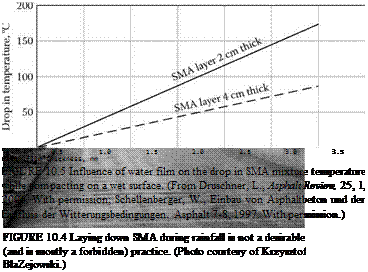Wind and Rain
There are additional requirements regarding issues such as wind speed at the laydown site in many national specifications. Let us take the Polish guidelines WT2 2008, for instance, in which the maximum allowable wind speed has been set at 16 m/sec (58 km/hr). The values of wind speed at the construction site are undoubtedly a factor of tremendous significance, especially when placing thin courses of SMA.

Frequent rainfall and the necessity of placing an SMA on a wet underlying layer are problems that often beset road builders. Most regulations do not allow SMA laydown on a wet surface or during rainfall (Figure 10.4). The layer of water covering the surface of the underlying layer causes a rapid drop in the SMA mixture temperature and also counteracts the formation of durable interlayer bonding. It has been estimated that a layer of
water about 1 mm thick causes a drop in the temperature of a 4-cm thick SMA course of about 30°C (Druschner, 2006). All in all, the thinner the SMA course being placed on a wet surface, the faster the mixture gets cold. Figure 10.5 shows the relationship between the amount of water on a surface and the drop in the mixture temperature.
Obviously a mixture should not be laid on a frozen surface or on one covered with snow or ice. But keep in mind that, when justified, the supervising engineer may approve carrying out works in unfavorable conditions, provided that all requirements with reference to the achieved properties of a course are satisfied. Typical technical regulations have stipulated that the laydown of an asphalt mixture in adverse conditions might be permitted as long as the following are true:
• All final requirements for the course are fulfilled.
• Good bonding of structural and wearing courses is secured.
• Good performance of construction joints is guaranteed.






Leave a reply